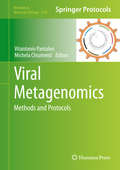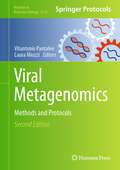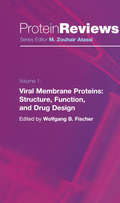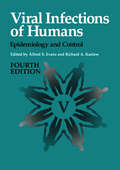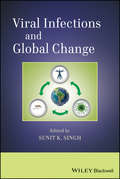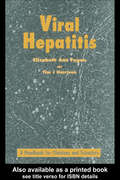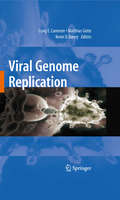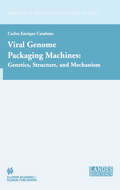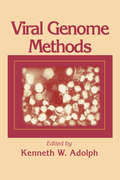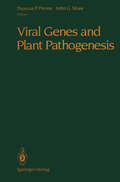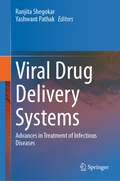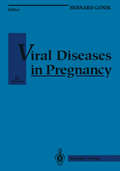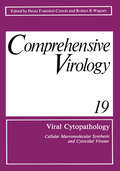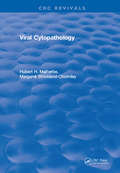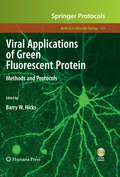- Table View
- List View
Viral Molecular Machines (Advances in Experimental Medicine and Biology #726)
by Michael G. Rossmann and Venigalla B. RaoThis book will contain a series of solicited chapters that concern with the molecular machines required by viruses to perform various essential functions of virus life cycle. The first three chapters (Introduction, Molecular Machines and Virus Architecture) introduce the reader to the best known molecular machines and to the structure of viruses. The remainder of the book will examine in detail various stages of the viral life cycle. Beginning with the viral entry into a host cell, the book takes the reader through replication of the genome, synthesis and assembly of viral structural components, genome packaging and maturation into an infectious virion. Each chapter will describe the components of the respective machine in molecular or atomic detail, genetic and biochemical analyses, and mechanism. Topics are carefully selected so that the reader is exposed to systems where there is a substantial infusion of new knowledge in recent years, which greatly elevated the fundamental mechanistic understanding of the respective molecular machine. The authors will be encouraged to simplify the detailed knowledge to basic concepts, include provocative new ideas, as well as design colorful graphics, thus making the cutting-edge information accessible to broad audience.
Viral Metagenomics: Methods and Protocols (Methods in Molecular Biology #1746)
by Vitantonio Pantaleo Michela ChiumentiThis volume explores the use of viral metagenomics to diagnose known viruses for plant and food production, human and animal health, and identifying viral vectors like insects. The chapters in this book cover topics, such as sRNAs isolation from tissues of grapevines and woody plants, high-resolution screening of arthropod and plant viral communities, identifying new pathogens in fish, detecting viruses in mycorrhizal fungi and their orchid host, and insect virus discovery through metagenomic and cell culture-based approaches. Written in the highly successful Methods in Molecular Biology series format, chapters include introductions to their respective topics, lists of the necessary materials and reagents, step-by-step, readily reproducible laboratory protocols, and tips on troubleshooting and avoiding known pitfalls.Authoritative and comprehensive, Viral Metagenomics: Methods and Protocols is a valuable resource for researchers and specialists who are interested in learning more about this evolving field.
Viral Metagenomics: Methods and Protocols (Methods in Molecular Biology #2732)
by Vitantonio Pantaleo Laura MiozziThis second edition volume expands on the previous edition with discussions about the latest viral metagenomics aspects covering a range of different specimens such as soil, freshwater, wastewater, fecal samples, blood plasma, clinical tissues, fungi, and herbarium samples. Chapters also look at different viral groups including archaeal viruses, eukaryotic viruses, phages, mycoviruses, and circular DNA viruses. Techniques required for studying the three viral metagenomic steps of samples processing, library construction, and analysis of data are also discussed. Written in the highly successful Methods in Molecular Biology series format, chapters include introductions to their respective topics, lists of the necessary materials and reagents, step-by-step, readily reproducible laboratory protocols, and tips on troubleshooting and avoiding known pitfalls.Authoritative and cutting-edge, Vital Metagenomics: Methods and Protocols, Second Edition is a valuable resource for researchers who are interested in learning more about this important and developing field.
Viral Membrane Proteins: Structure, Function, and Drug Design (Protein Reviews #1)
by Wolfgang B. FischerIn Viral Membrane Proteins: Structure, Function, and Drug Design, Wolfgang Fischer summarizes the current structural and functional knowledge of membrane proteins encoded by viruses. In addition, contributors to the book address questions about proteins as potential drug targets. The range of information covered includes signal proteins, ion channels, and fusion proteins. This book has a place in the libraries of researchers and scientists in a wide array of fields, including protein chemistry, molecular biophysics, pharmaceutical science and research, bioanotechnology, molecular biology, and biochemistry.
Viral Infections of the Human Nervous System (Birkhäuser Advances in Infectious Diseases)
by Alan C. JacksonViral infections of the nervous system are important because they are associated with high morbidity and mortality. A variety of pathogenetic mechanisms are involved in these infections and an understanding of the pathogenesis is essential in understanding the diagnostic and clinical management aspects of the disease. Specialized investigations are often necessary for definitive diagnosis, although a presumptive diagnosis should often be suspected on the basis of the clinical features. Many of the chapters in this book are written by neurologists who are experts in basic science research of their topic in addition to active clinical practice in their specialty.
Viral Infections of Humans: Epidemiology and Control
I prepared this preface to the fourth edition of Viral Infections of Humans alone and with mixed emotions. It was immensely gratifying when Al Evans invited me to join him in producing the new edition. After following at a distance his exemplary career as a scholar and gentleman in every sense of those words, I was filled with anticipation at the privilege of observing close at hand the thoughtful dedication he had previously brought to editorial process. However, work together soon the our was overshadowed by the condition that would slowly take him from our task and our midst. As we both increasingly realized that his declining health might prevent him from seeing this final product, the initial gratification that I had felt gave way to a sense of awesome responsibility for perpetuating his masterful blend of science and literacy. From the earliest days in the planning of this revision, Al and I recognized the profound changes taking place both in the knowledge of viral infections and in the way that knowledge was being gathered. With all of biomedical science moving in the rush of revolution, every discipline generating information relevant to this text-from virology, immunology, and pharmacology to epidemiology and neuropsychology-has been swept along in the torrent, propelled principally by two synergizing technologic forces: molecular biology and cybernetics.
Viral Infections and Global Change
by Sunit K. SinghA timely exploration of the impact of global change on the emergence, reemergence, and control of vector-borne and zoonotic viral infections From massively destructive "superstorms" to rapidly rising sea levels, the world media is abuzz with talk of the threats to civilization posed by global warming. But one hazard that is rarely discussed is the dramatic rise in the number and magnitude of tropical virus outbreaks among human populations. One need only consider recent developments, such as the spread of chikungunya across southern Europe and dengue in Singapore, Brazil, and the southern United States, to appreciate the seriousness of that threat. Representing a major addition to the world literature on the subject, Viral Infections and Global Change explores trends of paramount concern globally, regarding the emergence and reemergence of vector-borne and zoonotic viruses. It also provides up-to-date coverage of both the clinical aspects and basic science behind an array of specific emerging and reemerging infections, including everything from West Nile fever and Rift Valley fever to zoonotic hepatitis E and human bunyavirus. Important topics covered include: Epidemiology, molecular pathogenesis, and evolutionary mechanisms Host-pathogen interactions in an array of viral infections The impact of climate change on historical viral outbreaks The roles of socioeconomics, human behavior, and animal and human migrations The growing prevalence of drug and pesticide resistance The introduction of microbes and vectors through increased transboundary travel Spillover transmissions and the emergence of viral outbreaks Detecting and responding to threats from bioterrorism and emerging viral infections Predictive modeling for emerging viral infections Viral Infections and Global Change is an indispensable resource for research scientists, epidemiologists, and medical and veterinary students working in ecology, environmental management, climatology, neurovirology, virology, and infectious disease.
Viral Infections and Global Change
by Sunit K. SinghA timely exploration of the impact of global change on the emergence, reemergence, and control of vector-borne and zoonotic viral infections From massively destructive "superstorms" to rapidly rising sea levels, the world media is abuzz with talk of the threats to civilization posed by global warming. But one hazard that is rarely discussed is the dramatic rise in the number and magnitude of tropical virus outbreaks among human populations. One need only consider recent developments, such as the spread of chikungunya across southern Europe and dengue in Singapore, Brazil, and the southern United States, to appreciate the seriousness of that threat. Representing a major addition to the world literature on the subject, Viral Infections and Global Change explores trends of paramount concern globally, regarding the emergence and reemergence of vector-borne and zoonotic viruses. It also provides up-to-date coverage of both the clinical aspects and basic science behind an array of specific emerging and reemerging infections, including everything from West Nile fever and Rift Valley fever to zoonotic hepatitis E and human bunyavirus. Important topics covered include: Epidemiology, molecular pathogenesis, and evolutionary mechanisms Host-pathogen interactions in an array of viral infections The impact of climate change on historical viral outbreaks The roles of socioeconomics, human behavior, and animal and human migrations The growing prevalence of drug and pesticide resistance The introduction of microbes and vectors through increased transboundary travel Spillover transmissions and the emergence of viral outbreaks Detecting and responding to threats from bioterrorism and emerging viral infections Predictive modeling for emerging viral infections Viral Infections and Global Change is an indispensable resource for research scientists, epidemiologists, and medical and veterinary students working in ecology, environmental management, climatology, neurovirology, virology, and infectious disease.
Viral Hepatitis
by E.A. Fagan T.J. HarrisonThis book aims to bridge the widening rift between clinical and molecular aspects of viral hepatitis by providing an up-to-date overview of the field. The focus is practical and covers the limitations of clinical diagnosis, the interpretation of tests bas
Viral Hemorrhagic Fevers
by Sunit K. Singh Daniel RuzekViral hemorrhagic fevers have captured the imagination of the public and made their way into popular books and movies by virtue of their extreme virulence and mysterious origins. Since 2001, concerns have grown about the potential use of many hemorrhagic fever viruses as biological weapons. This has led to a resurgence in research to develop improv
Viral Genome Replication
by Kevin D. Raney Craig E. Cameron Matthias GötteThis book provides the first comprehensive review of viral genome replication strategies, emphasizing not only pathways and regulation but also the structure-function, mechanism, and inhibition of proteins and enzymes required for this process.
Viral Genome Packaging: Genetics, Structure, and Mechanism (Molecular Biology Intelligence Unit)
by Carlos E. CatalanoViral Genome Packaging focuses on the process of genome "packaging" within a pre-formed viral procapsid. The chapters of this book concentrate on the biochemistry, enzymology and structural aspects of the genome packaging machinery. This book defines a broad mechanistic basis for the process across the prokaryotic and eukaryotic border, and for DNA and RNA viruses. The biochemical, biophysical and structural aspects of genome packaging are examined in detail.
Viral Genome Methods
by Kenneth W. AdolphMolecular biology and genetics techniques now dominate viral research in attempts to cure diseases such as AIDS. Viral Genome Methods is a practical guide to the newest molecular techniques, providing step-by-step protocols to be used in the laboratory. Recognized authorities and pioneers in viral research pass on their expertise to you.
Viral Genome Methods
by Kenneth W. AdolphMolecular biology and genetics techniques now dominate viral research in attempts to cure diseases such as AIDS. Viral Genome Methods is a practical guide to the newest molecular techniques, providing step-by-step protocols to be used in the laboratory. Recognized authorities and pioneers in viral research pass on their expertise to you.
Viral Genes and Plant Pathogenesis
by Thomas P. Pirone John G. ShawThe chapters in this book represent detailed versions of papers presented at the Symposium on Viral Genes and Plant Pathogenesis held at Lexington, Kentucky on October 16 and 17, 1989. In selecting topics and authors, we attempted to have represented a spectrum of systems which are at the forefront of research on plant virus genes and gene products, particularly as they relate to plant disease. The book also contains pertinent discussion of the papers presented at the symposium, as well as summaries, observations and projections of future research directions prepared by the session chairmen. We wish to express our appreciation to Dr. D. L. Davis, of the RI. Reynolds Tobacco Company for suggesting the organization of the Symposium and the publication of the proceedings, and to the R 1. Reynolds Tobacco Company for the financial support which made the symposium possible. We also wish to thank those of our colleagues in the Department of Plant Pathology, University of Kentucky, who very ably and in many ways contributed to the organization and conduct of the conference. Thomas P. Pirone lohnG. Shaw v Contents Preface . . . . . . . . . . . . . . . . . . . . . . . . . . . . . . . . . . . . . . . . . . . . . . . . . . . . . . . . . . . . . . . . . . . . . . . . . . . . . . . . . . . . . . . . . . . . . . . . . . . . . . . . . . . . . . . . . . . . . . . . . . . . . . . . . . . . . . . . . . . . . . . . . . . . . . . . . . . . . . . . . . . . . . . . . . v Contributors . . . . . . . . . . . . . . . . . . . . . . . . . . . . . . . . . . . . . . . . . . . . . . . . . . . . . . . . . . . . . . . . . . . . . . . . . . . . . . . . . . . . . . . . . . . . . . . . . . . . . . . . . . . . . . . . . . . . . . . . . . . . . . . . . . . . . . . . . . . . . . . . . . . . . . . . . . . xi INDUCTION OF HOST GENES BY THE HYPERSENSITIVE RESPONSE OF TOBACCO TO VIRUS INFECTION J. F. Bol, C. M. A. van Rossum, Bl. C. Cornelissen and H. J. M. Linthorst . . . . . . . . . . . . . . . . . l COAT PROTEIN MEDIATED RESISTANCE IN TRANSGENIC PLANTS Roger N. Beachy . . . . . . . . . . . . . . . . . . . . . . . . . . . . . . . . . . . . . . . . . . . . . . . . . . . . . . . . . . . . . . . . . . . . . . . . . . . . . . . . . . . . . . . . . . . . . . . . . . . . . . . . . . . . . . . . . . . . . . . . . . . 13 STRUCTURE AND FUNCTIONS OF TOBACCO MOSAIC VIRUS RNA Yoshimi Okada, Tetsuo Meshi, and Yuichiro Watanabe . . . . . . . . . . . . . . . . . . . . . . . . . . . . . . . . . . . . . . . . . . . . . .
Viral Fitness and Evolution: Population Dynamics and Adaptive Mechanisms (Current Topics in Microbiology and Immunology #439)
by Esteban Domingo Peter Schuster Santiago F. Elena Celia PeralesThis book unifies general concepts of plant and animal virus evolution and covers a broad range of topics related to theoretical and experimental aspects of virus population dynamics and viral fitness. Timely topics such as viral mechanisms to cope with antiviral agents, the adaptability of the virus to new hosts, emergence of new viral phenotypes, and the connections between short- and long-term virus evolution are included. By comparing plant and animal viruses, universal mechanisms responsible for fitness variations, viral emergence and disease mechanisms are explored. Although emphasis is put on specific plant and human viral pathogens, relevant similarities and differences to other viruses are highlighted. Additionally, readers will learn more about the adaptability of coronaviruses, including the recently emerged SARS-CoV-2, the causative agent of the COVID-19 pandemic. The book is aimed at students and scientists interested in basic and applied aspects of plant and animal virus population dynamics and evolution.
Viral Fitness: The Next SARS and West Nile in the Making
by Jaap GoudsmitDespite vaccines and medicines, we have not succeeded in eradicating the most poisonous viruses in the world, like jaundice, measles, diarrhea, polio, and AIDS, not to mention newcomers like West Nile and SARS. Also, since September 11, it is no longer unthinkable that a terrorist would intentionally spread a virus among people or the food chain. In this book, Jaap Goudsmit argues that there is no such thing as life without viruses for many reasons; including the fact that many viruses spread without any visible signs, and can hide in animals; that there are too many different species of viruses and they multiply much faster than any animal or plant; and that infections strike especially in areas where life is difficult enough already, such as Africa and Asia. However, Goudsmit continues, if viruses hold onto life so stubbornly, perhaps they can be useful to other living beings. Do viruses offer people a better chance of survival in a hostile world? Do viruses make people fitter? Some viruses seem to play a role in the process whereby our genes adapt to the environment. What is it that makes viruses incredibly strong, and can we learn something from it? What is the secret of the enormous "fitness" of viruses? Will viruses spell the end of mankind or will man always be able to offer resistance? This book attempts to answer these and other questions.
Viral Expression Vectors (Current Topics in Microbiology and Immunology #158)
by Nicholas MuzyczkaIn the past ten years there has been enormous progress in the development of eukaryotic viral vectors. In general, these vectors have been developed for one of three reasons: to achieve high levels of expression of a particular gene product (poxvirus, baculovirus, and adenovirus), to clone eukaryotic genes in combination with functional assays (Epstein-Barr virus), of for use as delivery vehicles for the stable introduction of foreign genes into mammalian cells (retroviruses, Epstein-Barr virus, and adeno-associated virus). Each vector has its strengths and weaknesses that are rooted in the sometimes bewildering stra tegies that the parent viruses use for propagation. No one of these vectors is appropriate for all of the problems that a mole cular biology laboratory is likely to encounter, and few of us are knowledgeable in the molecular virology of all of these viruses. This volume represents an attempt by the authors to assem ble a review of these vectors in one place and in a form useful to laboratories that do not necessarily have experience with eukaryotic viruses. Clearly, any virus can be modified to serve as a vector for some purposes, and it was not possible to include a description of all of these. In addition, one eukaryotic vector, SV40 (the first one developed), has been reviewed so widely that we saw no reason to include it here.
Viral Entry into Host Cells (Advances in Experimental Medicine and Biology #790)
by Stefan Pöhlmann Graham SimmonsFor a virus to invade a host cell it needs to penetrate the physical barrier imposed by the plasma membrane. Viruses have evolved specialized surface proteins to meet this challenge. These proteins facilitate delivery of the viral genetic information into the host cell by either fusing the viral envelope with a host cell membrane or by forming membrane pores. Membrane fusion and pore formation critically depend on the engagement of host cell receptors and receptor choice is a key determinant of viral tropism. The multi-faceted interplay between viral and cellular factors during virus entry is a fascinating field of study, which can provide important insight into viral pathogenesis and define new targets for intervention. This book provides a comprehensive overview of this exciting field of research.
Viral Drug Delivery Systems: Advances in Treatment of Infectious Diseases
by Ranjita Shegokar Yashwant PathakThe disability-adjusted life year (DALY) is a generic measure of health effect that can be used in cost-effectiveness analysis as an alternative to the quality-adjusted life year (QALY). Infectious diseases are one of the major to cause significant losses of DALY and QALY. Human infectious diseases are disorders that are triggered by the micro-organisms such as bacteria, fungi, viruses, or parasites. The majority of such diseases are contagious and create a public health menace. There are several reasons why infectious diseases are deadly diseases, and one of the primary reasons is the drug resistance developed over time. Drug resistance-associated mutations are linked to increasing drug efflux, modifications of the drugs, or their targets. Every year, new drugs are being approved by FDA to treat infectious diseases. Nonetheless, the infectious diseases will undoubtedly persist as permanent and main threats to humanity for now and in the future, primarily due to increased longevity that almost always comes at a cost of impaired immunity.A total of four books are covered under the series of Infectious drug diseases.- Malarial drug delivery systems- Tubercular drug delivery systems- Viral drug delivery systems- Infectious disease drug delivery systemsThe third volume of series is focused on viral drug delivery systems. Typically, virus attaches to the cells (referred as host cell) and releases its DNA or RNA inside the cell. In second stage, virus’s genetic material takes control of the cell and forces it to replicate the virus leading to onset of disease symptoms. DNA class of viruses include Herpes, Papilloma and Adeno viruses. RNA class of viruses include retroviruses, such as HIV immunodeficiency virus and SARS COV – 2 / Corona virus. This book addresses recent developments in viral drug delivery systems. It covers many different aspects of viral infections, ways to treat them using modern drug delivery systems like nano particulate carriers. The choice of viral delivery systems mainly depends upon the type of virus, duration of life cycle, presence of drug resistance, cellular and mucosal interaction of virus, accordingly gene or non-gene drug delivery systems are selected. Besides that, this book also reports global dynamics of viral diseases, future predictions of infection rate, current treatment options, details of drug carriers like nanoemulsions, polymeric nanoparticles, role of biofunctionalization, and phyto-molecules in treatment of viral infections particularly herpes, Covid-19, Ebola, HIV/AIDS, influenza and viral hepatitis.Audiences from a broad range of groups, from researchers, academicians, and public health bodies to regulatory experts, can benefit from the compiled information to learn more about patient needs and current research advances in the field of viral drug delivery research.
Viral Diseases in Pregnancy (Clinical Perspectives in Obstetrics and Gynecology)
by Bernard GonikThe pregnant host is at risk for any of the viral diseases her nonpregnant counterpart acquires. Additionally, pregnancy heightens our concerns regarding specific viral diseases be cause of their potential for enhanced adverse effects on both maternal and fetal well-being. All too often the obstetrician relinquishes responsibility for the management of the gravida infected by a viral pathogen, and those expert in infectious diseases are confounded by the influence of pregnancy on these conditions. A major goal of this textbook is to narrow the gap between the two aforementioned management dichotomies in the virally infected pregnant woman. Weare at the infancy of our understanding of viral infections in pregnancy. The current and anticipated advancements are due in large part to a burgeoning oftechnological achievements in the areas of immunodiagnostics, molecular biology, and pharmacotherapeutics. Our in utero diagnostic capabilities, both invasive and noninvasive, have also allowed us new opportunities to study the effects of various maternal infectious disease processes on the developing fetus. New insights have been recognized pertaining to the maternal-fetal interface, the placenta, in that this structure is now acknowledged to function as both a mechanical and an immunological barrier to vertical transmission of infection. These observations suggest that there will be an outpouring of new data in the next several years that clinicians will need to master to maintain an appropriate level of expertise in the care of their patients.
Viral Cytopathology: Cellular Macromolecular Synthesis and Cytocidal Viruses Including a Cumulative Index to the Authors and Major Topics Covered in Volumes 1–19 (Comprehensive Cytopathology #19)
by Heinz Fraenkel-Conrat Robert R. WagnerThe time seems ripe for a critical compendium of that segment of the biological universe we call viruses. Virology, as a science, having passed only recently through its descriptive phase of naming and numbering, has probably reached that stage at which relatively few new-truly new-viruses will be discovered. Triggered by the intellectual probes and techniques of molecular biology, genetics, bio chemical cytology, and high resolution microscopy and spectroscopy, the field has experienced a genuine information explosion. Few serious attempts have been made to chronicle these events. This comprehensive series, which will comprise some 6000 pages in a total of 19 volumes, represents a commitment by a large group of active investigators to analyze, digest, and expostulate on the great mass of data relating to viruses, much of which is now amorphous and disjointed, and scattered throughout a wide literature. In this way, we hope to place the entire field in perspective, and to develop an invaluable reference and sourcebook for researchers and students at all levels. This series is designed as a continuum that can be entered any where, but which also provides a logical progression of developing facts and integrated concepts.
Viral Cytopathology
by MalherbeThis book is for the guidance of those wishing to use stained cultures for virus studies.In this manual, sufficient illustrations are presented that may not be otherwise readily available to the reader and indicate the wide range of cytopathic changes. However, it has been necessary to limit the size of the pictures to a minimum - enough to convince the reader that the technique can be of great practical value for the recognition of many different viruses.
Viral Cytopathology
by MalherbeThis book is for the guidance of those wishing to use stained cultures for virus studies.In this manual, sufficient illustrations are presented that may not be otherwise readily available to the reader and indicate the wide range of cytopathic changes. However, it has been necessary to limit the size of the pictures to a minimum - enough to convince the reader that the technique can be of great practical value for the recognition of many different viruses.
Viral Applications of Green Fluorescent Protein: Methods and Protocols (Methods in Molecular Biology #515)
by Barry W. HicksOver the last ten years, Green Fluorescent Proteins, along with the other spectral variants, have emerged from near obscurity to become a powerful and versatile tool in scientific research. In Viral Applications of Green Fluorescent Protein: Methods and Protocols, leading investigators from around the world contribute detailed examples of both the construction and application of fluorescent proteins delivered by viruses in a format crafted to produce rapid, readily reproducible results. Written in the style of the popular and successful Methods in Molecular Biology™ series, the chapters include brief introductions to the topics, lists of the necessary materials and reagents, step-by-step laboratory protocols, and Notes sections, which highlight tips on troubleshooting and avoiding known pitfalls.Cutting-edge and easy to use, Viral Applications of Green Fluorescent Protein: Methods and Protocols supplies researchers with an ideal guide to the many uses of GFP and a vital starting point for future studies utilizing this highly adaptable protein.

